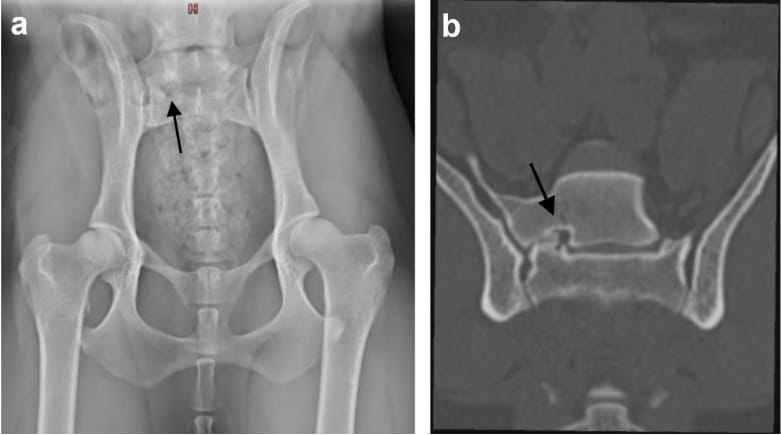- Veterinary View Box
- Posts
- Transitional Lumbosacral Vertebrae in Hunting Dogs: Uncovering a Link to Lower Back Pain
Transitional Lumbosacral Vertebrae in Hunting Dogs: Uncovering a Link to Lower Back Pain
Acta Veterinaria Scandinavica (2025)
Jon Andre Berg, Bente Kristin Saevik, Frode Lingaas, Cathrine Trangerud
Background
Lumbosacral transitional vertebra is a congenital anomaly in dogs that has been linked to cauda equina syndrome, particularly in German Shepherds. However, its association with lower back pain in other breeds remains unclear. This study aimed to determine whether lumbosacral transitional vertebra is linked to lower back pain in Black Norwegian Elkhound and Brittany dogs by combining owner assessments, clinical evaluations, and advanced imaging findings.
Methods
A prospective study was conducted on 32 privately owned dogs from the two breeds, selected based on their lumbosacral transitional vertebra type and balanced for age, sex, and hip dysplasia status. Owners completed a pain assessment questionnaire, and all dogs underwent neurological and orthopedic examinations. Advanced imaging techniques, including computed tomography and magnetic resonance imaging, were used to identify potential pathological changes associated with lumbosacral transitional vertebra.
Results
Dogs with lumbosacral transitional vertebra type 2 (57%) and type 3 (70%) exhibited significantly higher rates of mild lower back pain compared to those with normal anatomy or type 1 transitional vertebra (p = 0.012). Imaging findings confirmed pathological changes in dogs with these vertebra types, resembling degenerative lumbosacral stenosis. Affected dogs were younger (median 4.1 years) and lighter (median 14.5 kg) than those typically diagnosed with degenerative lumbosacral stenosis. Interestingly, despite the clinical findings, owners generally perceived their dogs as pain-free.
Limitations
The study's small sample size and breed-specific focus may limit generalizability to other dog breeds. Owner-reported pain assessments may have underestimated true pain levels. Additionally, imaging findings were not validated against histopathology, limiting the confirmation of degenerative lumbosacral stenosis diagnoses.
Conclusions
Lumbosacral transitional vertebra types 2 and 3 are associated with mild lower back pain in Black Norwegian Elkhound and Brittany dogs, supported by advanced imaging findings. While owners often did not recognize pain symptoms, veterinary assessments and imaging suggest that these dogs may be predisposed to early degenerative lumbosacral changes. Future studies should further investigate the long-term implications and potential preventive measures.

(a+b) a) A ventrodorsal radiograph, b) Computed tomography (CT) dorsal bone window. A female Brittany, 3.3 years old, illustrating a lumbosacral transitional vertebra (LTV) type 3 [8] with an articulation of the LTV segment with sacrum on the right side, causing ipsilateral foraminal stenosis of the sacral foramen (black arrow)
How did we do? |
Disclaimer: The summary generated in this email was created by an AI large language model. Therefore errors may occur. Reading the article is the best way to understand the scholarly work. The figure presented here remains the property of the publisher or author and subject to the applicable copyright agreement. It is reproduced here as an educational work. If you have any questions or concerns about the work presented here, reply to this email.